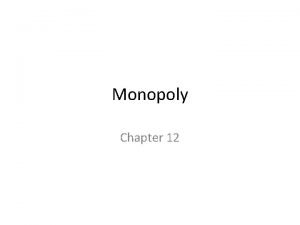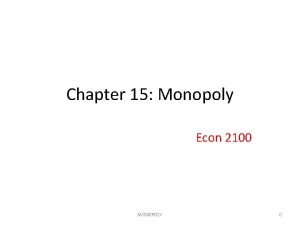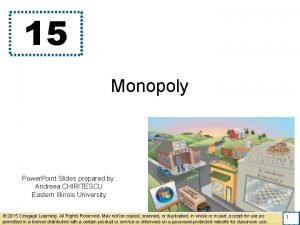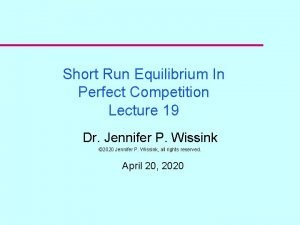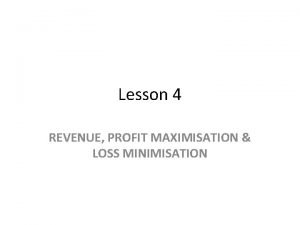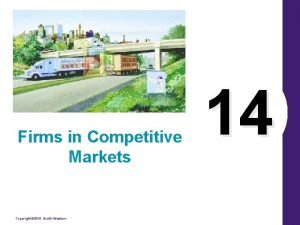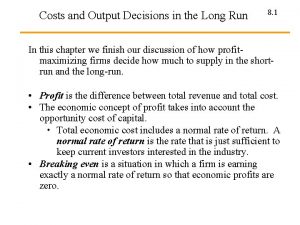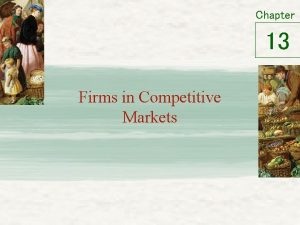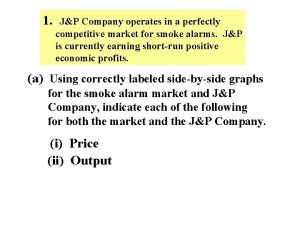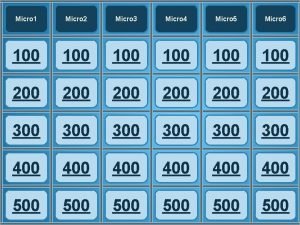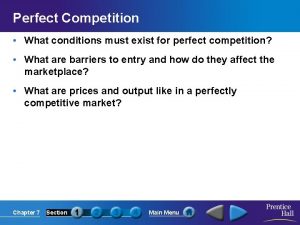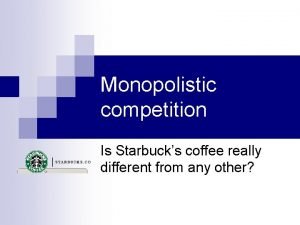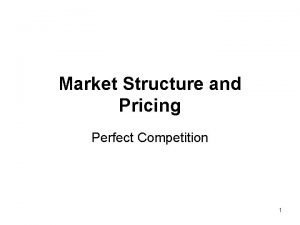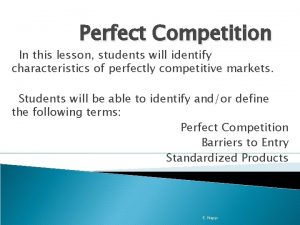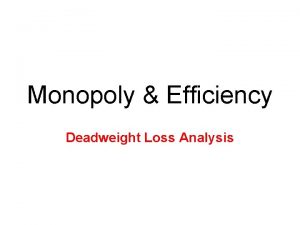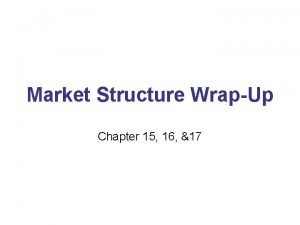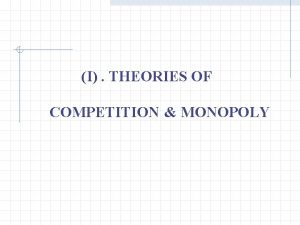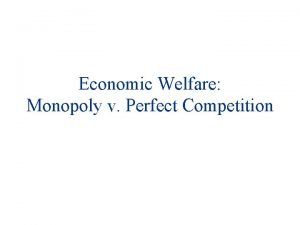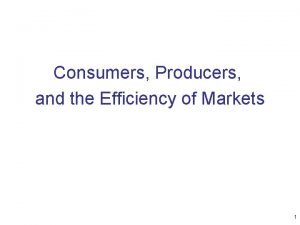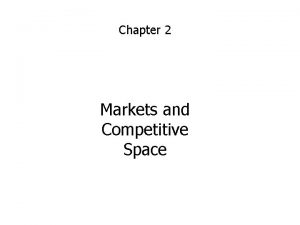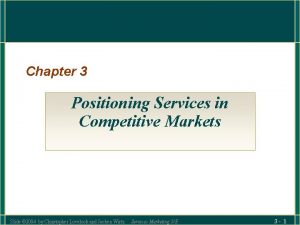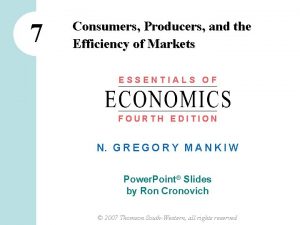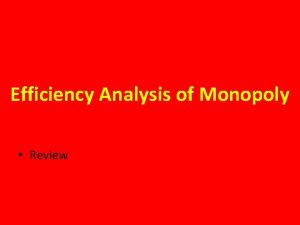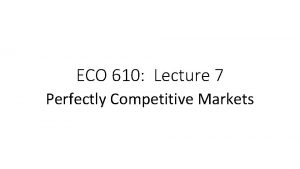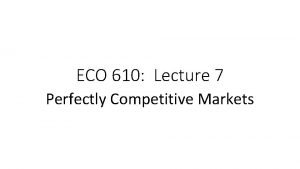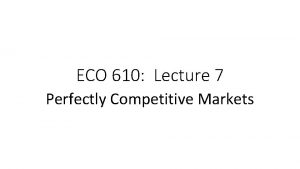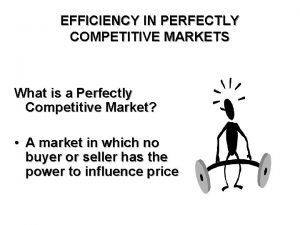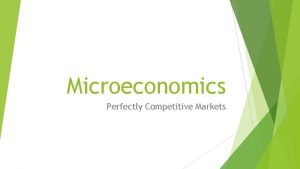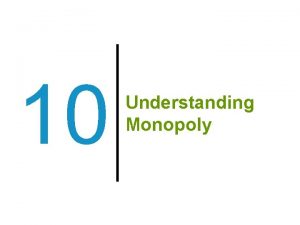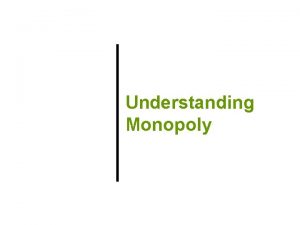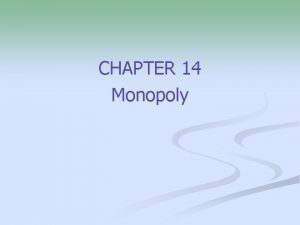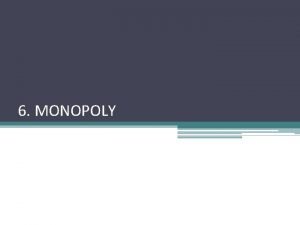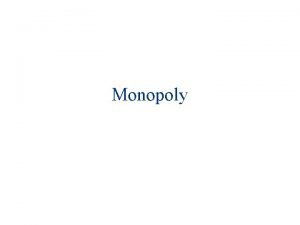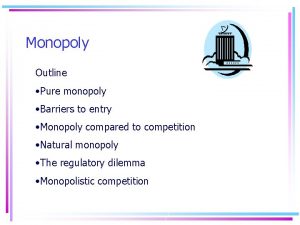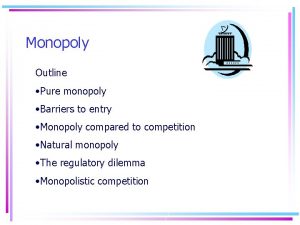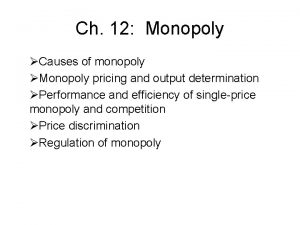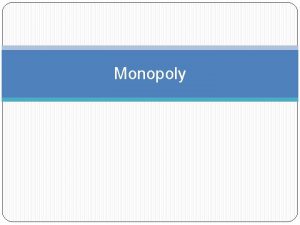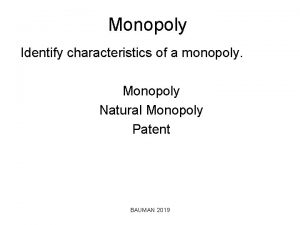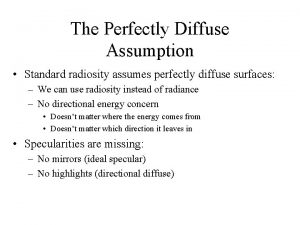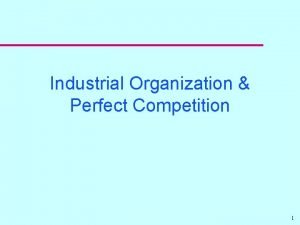Efficiency Analysis of Monopoly Review Perfectly Competitive Markets























- Slides: 23

Efficiency Analysis of Monopoly • Review

Perfectly Competitive Markets … • In the COMPETITIVE market equilibrium where D = S or where the marginal benefit/utility (MB, MU) is equal to marginal cost, (MB = MC or P = MC) • Allocative Efficiency or Pareto Optimality was achieved • The social (or community) surplus (sum of consumer and producer surpluses) is at its maximum and there is no welfare loss. • In perfect competition: • P = AR = Demand curve or MB is ALSO equal to MR (because firm is a price-taker) • Profit maximization of MR = MC P = MC

• In LR, in addition to Allocative Efficiency, Productive Efficiency where P = min ATC is achieved through the free barriers to entry and exit to the market • But this is not the case for monopoly and other forms of imperfect competition because P>MR and because there are ENTRY BARRIERS

Productive Inefficiency Free entry and exit to the perfectly competitive market changes the price so that no firm will be making a profit or loss. In such a case, the price in long-run equilibrium is where it intersects the ATC as its minimum point • But for the monopoly, output produced is not at the point of minimum ATC. The monopolist is producing at a higher than minimum ATC and is therefore, productively inefficient in addition to being allocatively inefficient. • In addition, the monopolist may become complacent and less innovative because no threat of competition But remember that the monopoly or oligopoly may be more dynamically efficient, offering consumers a greater variety of goods and more innovations.

Evaluation: HOWEVER………. • Although, standard conceptual analysis illustrates that monopoly would lead to allocative and productive inefficiency, there are some favorable outcomes with monopoly: • Product development and technological innovation. With profits and barriers to entry, the monopolist can spend money on R&D. • Possibility of greater efficiency and lower prices due to technological innovation • Economies of scale with falling ATC over a large range of output and firm scale. It could potentially gravitate towards the PC market price and quantity levels • Case of natural monopoly

Natural Monopoly • Natural monopoly is a firm that has economies of scale so large that it is possible for the single firm alone to supply the entire market at a lower average cost than two or more firms (producing at a higher cost)

Allocative Inefficiency of Imperfect Competition: Review • Whereas the perfectly competitive industry achieves allocative efficiency (maximum social surplus) shown by MB = MC, monopoly does not. This is shown as follows

RECAP • Allocative inefficiency at the monopolist outcome (Pm and Qm), because MB > MC meaning that there is an underallocation of resources to the good and consumers are not getting as much of it as they would have liked. Society would have been better off if more of the good was provided. • Allocative efficiency is therefore not achieved. • monopoly/imperfect competion/collusion is therefore an example of • Market Failure

BUT remember that aim might NOT be π maximisation • In reality, firm’s operations can be motivated by other aims • Revenue maximization – with separation of management from ownership, CEOs tend to care more about sales while owners/shareholder care more about profits • Growth maximization – firms can be more interested in the change, the sense of progress (start to end). Growing firm signifies economies of scale, market power, diversification, reduction in risks, etc. • Managerial utility maximization – CEOs maybe interested more in sales, benefits, employment, etc. • Satisficing – not maximising profit, revenue, growth or managerial utility, but reach a satisfactory level in each one • Ethical and environmental concerns and corporate social responsibility – image, to avoid regulation and taxes. Rising consumer awareness of corporate behavior and environment

Market Failure New handout

Definitions & Terminology • Allocative efficiency (Pareto Optimality) is where • MARGINAL SOCIAL BENEFIT = MARGINAL SOCIAL COST (draw on a diagram) • If there is allocative inefficiency, too much or too little of goods or services are produced and consumed from the point of view of what is socially most desirable. Overprovision of a good means too many resources are allocated to its production (overallocation); underprovision means that too few resources are allocated to its production (underallocation)

Market Failure In the real world, free markets often “fail” to achieve allocative efficiency • The causes of “market failure” 1. 2. 3. 4. 5. 6. Imperfect competition Externalities Collectively consumed (“public” )goods Common access resources Asymmetric/Imperfect information e. g. case of insurance and/or Irrational buyers: case of financial crisis Inequitable distribution of income? • When a market fails, it justifies • government intervention • e. g. taxes, subsidies, regulation, price controls, government provision of the good

Regulating Monopolies and Imperfect Competition (Competition Policies)

Types of government control/regulations/policies • GOVERNMENT AGENCIES: • USA: Anti-trust legislation • Japan: FTC (Fair Trades Commission) 公正取引委員会 • Europe : Competition Council • UK: Monopolies Commission

Japan’s FTC公正取引委員会 • The commission investigates situations and may issue warnings • It can impose monetary penalties (fines) based on prescribed formulas – eg 10% of relevant sales for price-fixing, 6% for engaging in exclusionary private monopolies • If two large companies want to merge, they will need FTC approval first (based on market share etc)

EXAMPLES of FTC actions: • Japan’s Fair Trade Commission: Japanese regulators raided the offices of five shipping lines in 2013 over allegations they discussed raising rates together for transporting cars, and imposed fines on Nippon Yusen and Kawasaki Kisen in January, 2014. • EXAMPLE of PRICE-FIXING or PRICE-RIGGING by COLLUSION

FTC warns Costco Japan, Baron Park for engaging in gasoline price war • • • The nation’s antimonopoly watchdog has issued a warning to two gasoline retailers over a price war Costco Wholesale Japan Ltd. and Japanese oil products retailer Baron Park Co. sold regular gasoline at their gas stations in Tokoname, Aichi Prefecture, at between ¥ 86 and ¥ 87 per liter for 10 days through Nov. 27. This compares with retail gasoline prices that averaged ¥ 123 to ¥ 129 in the prefecture The prices were “excessively below” the costs of procuring the gasoline, the Fair Trade Commission said in a statement Thursday. This was likely to cause “difficulties to the business activities of other petroleum products retailers in the surrounding area. ” (may cause bankruptcies and therefore lead to a more highly concentrated industry) EXAMPLE of PREDATORY PRICING

PROCESS • a) Identify whether a monopolistic situation by looking at : • 1) market shares or concentration ratios • 2) existence of COLLUSION or CARTEL • 3) existence of entry barriers • 4) restrictive practices? • Determine whether or not against consumer interests

Examples of Restrictive practices (H/O) • bid-rigging (eg dango among construction firms) • Price-rigging • entry barriers (eg Fuji film) • Predatory pricing (eg Usen cable radio) • Vertical restraints (eg French perfume makers)

POLICIES: legislation and regulation to reduce monopoly • • Break up the monopoly (very rare) Fines Forbid restrictive practices Mergers and acquisition laws (e. g. Panasonic’s acquisition of Sanyo had to be approved by the FTC) • Nationalization (ie state ownership) In addition, could require the firm to follow (not compulsory part of IB syllabus) • Marginal cost pricing charge the P which is equal to MC • Average cost pricing where price is determined by the intersection of the demand curve and ATC

Marginal Cost Pricing • The government can step in and regulate the monopoly to charge P = MC, the allocatively efficient outcome • Qmc is larger than the unregulated monopoly outcome of Qm and Pmc is lower than Pm • Consumers and society at large are better off as resources are allocated efficiently • But, this leads to loss for the monopolist as Pmc lies below ATC at point of production Qmc thus impractical policy as monopolist would shut down in the LR unless the government provides a subsidy

Average Cost Pricing • To avoid creating losses, governments can force the firm to charge a P = ATC, determined by the intersection of the demand curve and ATC • This is also known as the “fair return pricing” as monopolists are forced to earn normal profit • Pac and Qac are not the allocatively efficient outcome, but it is superior to the outcome achieved by the unregulated monopoly

(continued) • Society would benefit from average cost pricing but it has disadvantages • e. g. in an unregulated market, monopolist has the incentive to keep ATC low in order to maximize profits. But if P is forced to set at ATC, there is no incentives to lower ATC, leading to inefficiency and the price to go up • So in reality, there is a lot of negotiations and lobbying between the government and the companies – The world of political economy!
 Theory of monopoly
Theory of monopoly Perfectly price discriminating monopoly
Perfectly price discriminating monopoly Price discriminating monopolist graph
Price discriminating monopolist graph Perfectly price discriminating monopoly
Perfectly price discriminating monopoly Perfectly competitive short run supply curve
Perfectly competitive short run supply curve Profit maximization
Profit maximization Short run supply curve for a perfectly competitive firm
Short run supply curve for a perfectly competitive firm Minimum point of average cost curve
Minimum point of average cost curve Perfectly competitive short run supply curve
Perfectly competitive short run supply curve J p company operates in a perfectly competitive
J p company operates in a perfectly competitive A farmer produces peppers in a perfectly competitive market
A farmer produces peppers in a perfectly competitive market How are market failures different from perfect competition
How are market failures different from perfect competition For an industry to be perfectly competitive what must exist
For an industry to be perfectly competitive what must exist Starbucks oligopoly
Starbucks oligopoly Perfectly competitive market example
Perfectly competitive market example List the four conditions for perfect competition.
List the four conditions for perfect competition. P = mc
P = mc Allocative efficiency monopoly
Allocative efficiency monopoly X efficiency monopoly
X efficiency monopoly Deadweight loss in perfect competition
Deadweight loss in perfect competition Consumers producers and the efficiency of markets
Consumers producers and the efficiency of markets Product market boundary structure
Product market boundary structure Positioning services in competitive markets
Positioning services in competitive markets Consumers producers and the efficiency of markets
Consumers producers and the efficiency of markets
